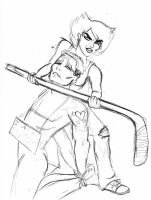When you think of tools essential to doctors and medical students, a sketchbook might not be the first thing that comes to mind. However, sketchbooks play a surprisingly vital role in the medical field, offering unique ways to enhance learning, improve understanding, and even provide a creative outlet. Whether it’s sketching the anatomy of the human body or documenting complex medical cases, sketchbooks have proven to be invaluable for those in the medical profession.
The Importance of Sketchbooks in Medical Education
For medical students, sketchbooks are much more than simple notebooks. They serve as an interactive and visual medium to comprehend the intricate details of the human body, diseases, and medical procedures.
1. Learning Anatomy and Physiology
Medical students often use sketchbooks to study and internalize the structure and function of the body. Creating their own diagrams and sketches of organs, muscles, and bones can help solidify their understanding.
Benefits of Sketching Anatomy:
- Encourages active learning by engaging multiple senses.
- Helps students visualize and retain detailed anatomical structures.
- Builds a strong foundation for practical medical applications.
2. Documenting Case Studies
Doctors and medical students often use sketchbooks to record clinical cases, symptoms, and treatments. Drawing diagrams or charts in their sketchbooks helps in organizing and reviewing patient information.
Why It’s Effective:
- Creates a personalized record of clinical experiences.
- Simplifies complex medical data into visual formats.
- Encourages critical thinking and problem-solving.
How Doctors Use Sketchbooks in Their Practice
For practicing doctors, sketchbooks remain a valuable tool for communication, creativity, and learning. They’re not just about documentation; they’re about improving the quality of care and innovation.
Communicating with Patients
Sometimes, explaining medical conditions or procedures to patients can be complicated. Doctors often use sketches in their sketchbooks to break down complex topics into simple visuals.
Examples:
- Illustrating a surgical procedure step-by-step for a patient.
- Drawing the affected area in the body to explain a diagnosis.
- Using sketches to show recovery progress over time.
Innovating in Medical Research
Doctors involved in research use sketchbooks to brainstorm, plan, and sketch out ideas for new medical techniques or equipment. Sketching provides a hands-on approach to problem-solving and innovation.
Fieldwork and Sketchbooks: A Unique Pair
In situations like medical fieldwork or humanitarian missions, technology may not always be available. Sketchbooks step in as a reliable, low-tech alternative for documentation and communication.
Recording Observations
Doctors in the field use sketchbooks to:
- Document findings in remote or underdeveloped areas.
- Draw visuals of diseases, injuries, or conditions for later study.
- Create case logs when electronic devices are unavailable.
Sharing Knowledge
Sketchbooks can act as tools to teach and train others in the field:
- Illustrating procedures for local healthcare workers.
- Sharing visual records during team meetings.
The Cognitive Benefits of Sketching for Medical Professionals
The act of sketching isn’t just practical—it also has cognitive benefits. Sketchbooks help doctors and medical students process and understand complex information more effectively.
Enhancing Memory and Retention
Studies show that drawing or sketching information helps in memorizing it. For medical students cramming for exams, sketching can be a lifesaver.
Developing Observation Skills
Regularly using sketchbooks sharpens observational abilities, which are crucial for diagnosing patients and recognizing symptoms.

Sketchbooks.org | ARTIST MARKETING GUIDE
How to Write an Effective Artist Statement | That Feels Authentic
What Makes an Artist Statement Effective Every artist, whether emerging or established, reaches a point where they must articulate their creative identity—and that’s where knowing how to write an effective artist statement becomes essential. Your...
Balancing Digital Tools with Sketchbooks
While digital tools like apps, tablets, and medical software have become ubiquitous in the healthcare industry, sketchbooks offer a timeless alternative. The two complement each other beautifully.
The Advantages of Sketchbooks
- Provide a distraction-free medium for focused work.
- Require no electricity, software updates, or internet connections.
- Offer a tactile and creative experience that digital tools can’t replicate.
Integrating Both Mediums
- Sketch initial ideas or diagrams in a sketchbook, then refine them digitally.
- Use sketches as the basis for creating digital presentations or teaching materials.
Tips for Making the Most of Your Sketchbook
If you’re a doctor or medical student looking to incorporate sketchbooks into your routine, here are some practical tips:
Choose the Right Sketchbook
- Opt for one with thick, durable paper that handles both writing and sketching.
- Consider portable sketchbooks for on-the-go use during rounds or fieldwork.
Make Sketching a Habit
- Dedicate a few minutes each day to sketching, even if it’s just quick anatomy studies or patient diagrams.
- Use your sketchbook consistently in lectures, rounds, or clinical settings.
Revisit and Reflect
- Review old sketches regularly to assess your growth and refresh your memory.
- Reflect on past case studies or diagrams to find patterns and insights.
The Enduring Relevance of Sketchbooks in Medicine
In an age dominated by digital technology, the continued use of sketchbooks by doctors and medical students highlights their irreplaceable value. Whether it’s for learning anatomy, documenting case studies, or innovating in research, sketchbooks provide a unique, hands-on way to engage with the complexities of medicine.
So if you’re in the medical field, consider making a sketchbook your new best friend. It might just become the tool you never knew you needed for learning, creating, and providing exceptional care.
Ready to Share Your Work?







